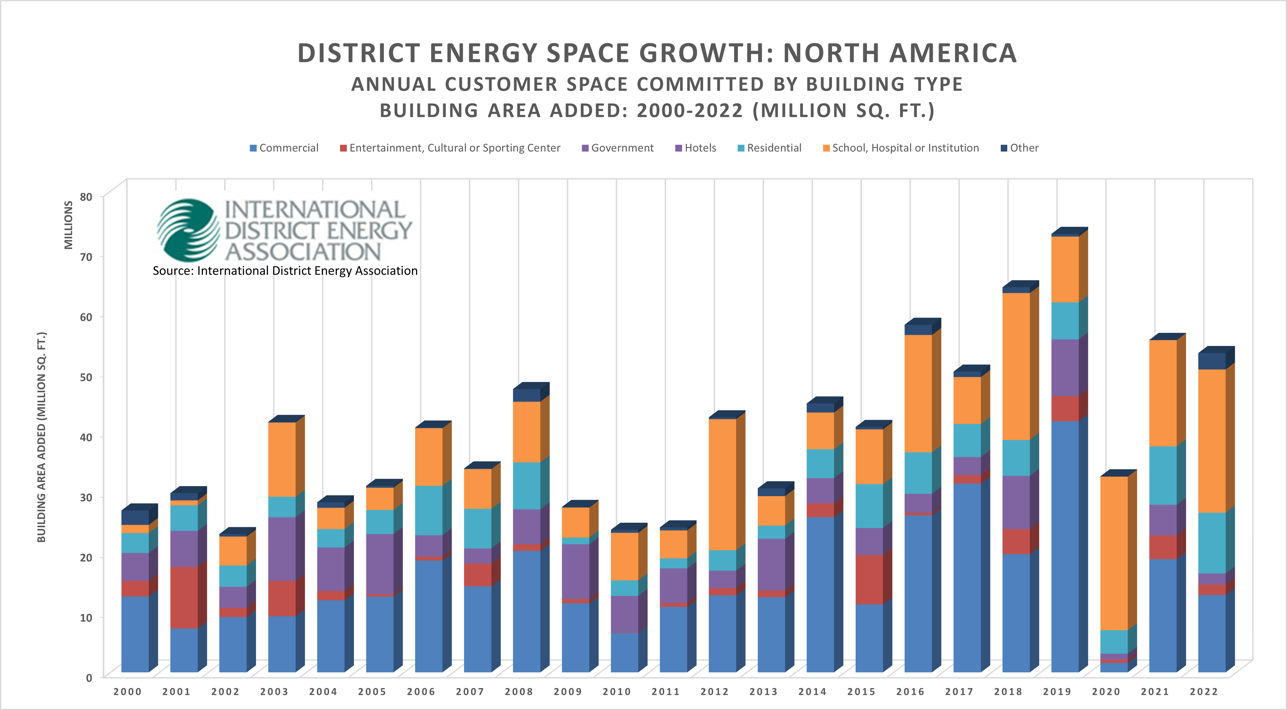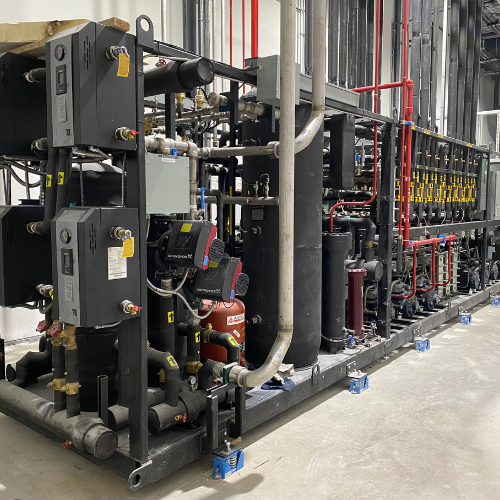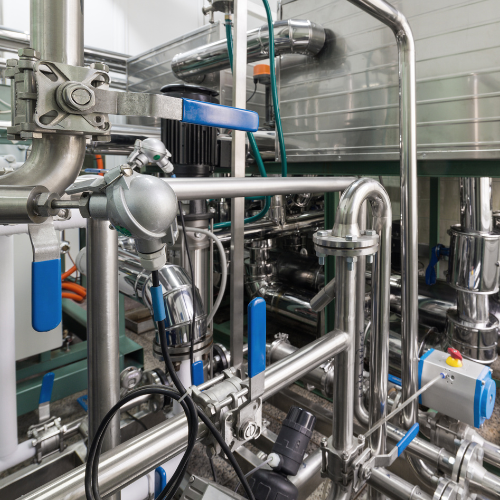As the clean energy transition gains momentum, district energy is becoming increasingly popular in North America as a way to meet the growing energy demand without overloading the electrical grid. When combined with thermal energy storage, district energy systems can act as a form of energy storage for the grid, absorbing excess electricity during off-peak hours and reducing demand during peak times. It also makes renewable electricity easier to store and use. This results in improved grid capacity and resilience – all while reducing greenhouse gas emissions and overall operating costs.
What is Thermal Energy Storage?
Thermal Energy Storage (TES) allows us to save energy when it is plentiful and use it when we need it most, making our heating and cooling systems more efficient and reliable. It can be added to a facility’s existing heating or cooling system, acting like a thermal battery to manage its energy use.
The thermal battery is charged during off-peak times, saving heating (or cooling) for later use. Then, when demand is high during peak times, the battery is discharged into the system, providing heating (or cooling) where needed.
This is not a new concept; it has been successfully implemented in North America in many different applications – from ice rinks to universities and even district energy systems (to name a few).
There are two types of TES: seasonal storage, which manages summer-winter load differences, and daily storage, which manages day-night differences. This article focuses on daily storage.
To understand how TES can benefit your facility, the first step is to analyze all current (and future) thermal loads, i.e., the operation's heating and cooling requirements. This will show annual and daily demand requirements, guiding the design process to ensure you select the best TES for your needs.
When looking at a 24-hour period, the daily load analysis usually reveals a significant difference between the load during peak times (in the day when occupancy is high) and off-peak times (usually at night, when demand is low).
By adding TES, the system can store energy during quiet nighttime hours when demand is low. Later, during busy periods when energy needs are high, it can release this stored energy. This clever approach meets peak demands without requiring extra equipment like chillers or heat pumps.
Choosing the Right TES System
TES systems use either sensible storage or latent storage. Each type has its own benefits and drawbacks, so the choice depends on a specific facility’s needs.
Sensible storage is the most common type. It uses a single-phase fluid (typically water). The fluid is then chilled or heated to the required temperature and stored in a large tank for later use. Throughout this process, the water stays in the liquid state – it does not change state.
Latent storage is less common and relies on changing the fluid's phase. Typically, it is deployed for chilled water systems. Also known as an “ice battery,” water is frozen and stored as ice in the off-peak hours to be melted (discharged) and used to chill the water loop.
Latent storage has an advantage over sensible storage because it can store the same amount of thermal energy in about one-eighth of the space, making it more compact. On the other hand, sensible storage systems are usually easier to run and cost less to set up initially.
Each type has its strengths, so the choice depends on specific needs and constraints.
TES End User Benefits
Thermal storage boosts system capacity cost-effectively without the need for extra chillers or heat pumps. In fact, TES installation costs about 40% less per kilowatt than adding the equivalent capacity with traditional equipment.
TES shines during power outages – another benefit. It can run on limited backup power, using less than one-fifth of the energy needed by chillers or heat pumps for the same output. This efficiency is crucial for conserving power until grid power returns.
TES also enhances system resilience. If a chiller or heat pump fails, the stored energy can provide backup heating or cooling during repairs.
Moreover, TES tanks are built to last. They maintain peak efficiency throughout a system's life, never degrading over time. This durability makes TES an ideal long-term investment for companies aiming to cut carbon emissions and reduce costs.
Growth of District Energy Systems
District energy is on the rise in North America. In 2023, the International District Energy Association (IDEA) reported a nearly 5% increase in buildings using these services, continuing a decade-long upward trend.
It is estimated that more than 660 district energy systems are operational in the US today. For Canada, the CEEDC lists 256 different sites, bringing the estimated total number of district energy systems in operation in North America to more than 900.
The North American district heating market is projected to grow by 5.4% annually between 2022 and 2028, according to Research and Markets. By 2028, the United States market value is expected to reach $32.77 billion. In Canada, a higher growth rate of 7.8% is anticipated, while Mexico is expected to grow at 6.9% during the same period.

IDEA data showing the growth of spaces connected to district energy systems in North America.
TES Benefits to District Energy Users
Most district energy customers face time-of-use or peak demand pricing from utilities. These pricing models encourage system operators to limit energy use during peak hours and shift demand to off-peak times when electricity is cheaper. This is where TES can be useful, enabling peak load shifting and cost savings.
Operators can strategically size and use TES to store energy during off-peak hours and release it during peak times. This approach can fully or partially shift peak demand, depending on the system's needs and available space for the TES installation.
The push to decarbonize district energy systems is driving TES adoption. An increasing number of operators are working to reduce their Scope 2 emissions (generated primarily from the electricity used to operate the district energy systems). Incorporating TES helps manage energy use more effectively, reducing these emissions.
As renewable energy sources like wind and solar power become more prevalent, reliance on fossil fuels is shifting. While these renewable sources usually meet the overall required power demand, the challenge is the timing of this power generation. For instance, wind power can only be generated when there is wind (which may not be when the power is needed).
This creates fluctuations in the grid, likely leading to more aggressive utility pricing structures from the utility companies. Even users with on-site renewable energy (behind the meter) have to manage these fluctuations.
By adding TES, this renewable energy can strategically be managed. Users can charge their TES when power is cheap and plentiful and then use stored energy when power is expensive or scarce. This approach optimizes both energy use and costs.
Additionally, the trend towards electrification is increasing demand for upgraded power infrastructure. TES can reduce the need for such upgrades by replacing additional chillers or heat pumps. This facilitates electrification, lessens grid strain, and supports the increased adoption of renewable electricity sources.
Can Your Facility Benefit from TES?
Thermal Energy Storage is a versatile solution that caters to the diversity of district energy systems. Whether your system is large or small, has a unique load profile, or operates under specific utility structures, TES can be tailored to fit. The technology is mature and offers a range of options, allowing for customized solutions for each facility and user.
While there is no one-size-fits-all approach to TES, its benefits are far-reaching. Most thermal systems stand to gain from this strategic investment, both now and in the future. An experienced TES provider can help you uncover these advantages for your specific situation.
Looking ahead, the future of urban energy is not just about generating power anymore. The global focus is shifting to smart distribution, efficient storage, and optimized use.
As we move towards a cleaner, more efficient energy future, district energy systems coupled with TES are not just an option – they are becoming an essential part of the solution. By embracing these technologies today, cities and communities are laying the groundwork for a more sustainable and energy-secure tomorrow.

Bashar Naser, P.Eng.
Business Development, District Heating and Cooling
Bashar’s extensive engineering expertise in industrial thermal solutions enables him to engage with stakeholders and identify optimal district energy solutions. His diverse experience in product development, manufacturing, commissioning, and customer support adds significant value to our customers projects.
Related Posts

DesLaurier Cold Storage

Comparison of Key Refrigeration System Components: Making the Right Choice for Your Operation
.png?sfvrsn=26cbdc22_3)
Ammonia Heat Pumps Achieve 185°F, Ditch the Boiler for Food & Beverage Production
|
|



